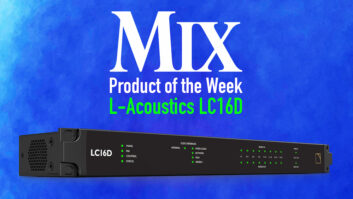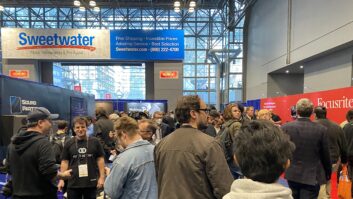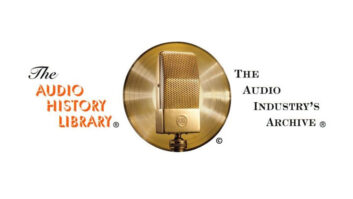
After celebrating its first World Series win, the city of San Francisco was still in a party mood when the 129th Audio Engineering Society convention (November 4-7) came into town. With the current state of the economy, a few regular exhibitors skipped this expo, but if there was a downturn in the industry, it certainly didn’t show on the faces of the thousands of enthusiastic attendees that packed into the Moscone Center for four days of nonstop pro audio action. Here are some of the highlights.
advertisement

Avid Pro Tools 9
THE BIG ONE
The big news at AES was certainly Avid’s release of Pro Tools 9. Far more than a simple software update, PT9 users now have the choice of working with the DAW in a $599 software-only stand-alone configuration or with a choice of Avid or third-party (Core Audio and ASIO) audio interfaces, and with Avid Artist and Pro Series controllers. The new software replaces Pro Tools LE and spans upward to Pro Tools 9 HD TDM. All versions now include Automatic Delay Compensation and EuCon support. Other features include support for 96 mono or stereo voices in the new software-only version of Pro Tools (192 voices with Pro Tools HD systems), 256 internal buses and 160 aux tracks.
After years of operating within a closed environment, this announcement was warmly greeted, not only by interface suppliers at AES (including Apogee, Focusrite, Lynx, RME and Prism), but also by users who now have more options from which to choose. In other DAW news, Stanford Research Systems—known for its audio test systems—debuted Perfection 10, a Rubidium Atomic audio clock source. Priced at $3,495, the two-rackspace unit has eight ultraprecision 10MHz BNC word clock outputs, all fed from an ultrastable rubidium oscillator with ±0.5ppb accuracy.
CONSOLES RULE
Solid State Logic (solidstatelogic.com) showed its next-generation AWS console/controllers, now in 24-input (AWS 924) and 48-input (AWS 948) variants—both using 24-fader footprints. Each AWS 948 channel has a single mic pre and two line inputs, a stereo insert and new stereo EQ with independent switching of each band between E and G Series tonal characteristics. Standard to both are motorized faders that follow DAW automation data, a new phase meter, LCD digital scribble strips, updated cosmetics and more.

Solid State Logic Nucleus
The company’s Nucleus is a $4,999 desktop I/O and controller with two banks of eight channel controls, center section controls, 100mm moving faders, digital scribble strips, assignable V-Pots and softkeys, user-customizable key-command mapping and communication via HUI and MCU. Also featured is a SuperAnalogue output to separate +4/-10dB connections, a stereo USB record/playback path to DAW, two combo XLR mic/line/instrument inputs and a Duende Native Essentials plug-in bundle.
Allen & Heath’s GS-R24 analog recording console has optional motorized faders and MIDI controllers for DAW interfacing. It has 24 mono input channels (each with mic pre and 4-band parametric EQ), two stereo channels, two tube channels, six aux sends and four subgroups. Optional is a 32-channel FireWire interface module (with digital send/returns on all input channels and the master stereo) and an analog I/O-plus-MIDI module. The MIDI control section has switches, rotaries, two MIDI faders, 24-channel faders and a jog wheel for scrolling functions.
API had heavy traffic throughout the three days from its central vantage
point in the 700 aisle. The company announced its 124th order for the
2-year-old 1608, then debuted The Channel Strip, made up of a 512c mic
pre, the famous 550A EQ, the 527 Compressor and the 325 Line Driver. Each
processing piece can be switched in or bypassed individually, and a Flip
switch allows the compressor to be placed after the EQ if desired. MSRP:
$2,995. And finally, proving that big studios are here to stay, API led a
six-manufacturer announcement at Restaurant Lulu for the rebuild/refurbish
of world-renowned Wisselloord in the Netherlands. There will be a Vision
going in, so watch this space for the ongoing news.
Malcolm Toft debuted his first new Trident console in 25 years. Shown in a 32×24 frame (40 and 48 inputs also offered), the Series 82 combines a flexible in-line and split monitoring design (96 inputs with EQ on remix), with expanded 4-band parametric EQ, sweepable HP filter, eight aux sends, classic Trident preamps with Lundahl transformers, full meter bridge, TT patchbay and D25 multipin interfacing to DAW or recorder. A 32×24 model is $68k; automation is optional.

Undertone Audio’s new console
Producer Eric Valentine and designer Larry Jasper launched a new 24-channel console under the Undertone Audio brand. All models are custom (up to 108 inputs), but include 24 buses, six aux sends and 4-band custom parametric EQ with a Shape control to create customized tone-shaping contours. The design uses all discrete, single-ended, Class-A circuitry in the signal path; output transformers are optional. The mixer’s Acoustically Transparent Work Surface™ is a patent-pending porous metal on the main console surface that’s said to eliminate acoustical reflections and comb-filtering effects from reference monitors on the meter bridge.

AEA KU4
MICS, MICS, MICS!
Every AES brings a load of new mics, and this show didn’t disappoint. There were plenty of new ribbon models. Royer showed its affordable ($895) R-101, which started shipping last month. But the big AES news was cardioid ribbon mics. AEA’s KU4 is a nod to RCA’s legendary unidirectional KU3A, with the smooth sound of a 44, a wide sweet spot and less proximity bass boost than traditional figure-8 ribbons. Features include NOS RCA ribbon material, custom AEA transformer and a high-quality anodized/nickel-plate finish. The beyerdynamic RM 510 is another cardioid ribbon design, but built into an interchangeable capsule head for use with the company’s Opus 600 and 900 handheld wireless systems.
advertisement

beyerdynamic RM 510
Mic designer Ben Sneesby brought his entire BeesNeez Microphones line of Australian-made condenser mics. The construction is first-class throughout, using point-to-point wiring, Cinemag transformers and NOS European and American tubes. After a quick headphone listen on the show floor, we definitely want to check these out in the studio. Microtech Gefell’s M 1030 features a cardioid pattern with a large-diameter capsule feeding a newly designed solid-state circuit topology. This transformerless design reduces the noise floor to a low 7 dBA while raising the maximum output capacity, resulting in a 135dB dynamic range.
Making its U.S. AES debut, the Schoeps SuperCMIT digital shotgun mic uses a unique dual-capsule design approach coupled with digital signal processing to minimize extraneous noise, increase range and retain the transparency and integrity of the source audio.
DPA launched its Reference Standard Mics, a new series of interchangeable mic capsules (omni/cardioid/shotgun/wide cardioid) and preamp bodies (compact, standard or standard with low-cut/high-boost switches). The range lets users create various combinations for specific applications (such as compact bodies for close-in piano miking) or simply have the versatility of having several capsules available without the expense of purchasing complete mics.
We love previewing stuff at AES that’s months away. Cascade showed a prototype of a large-body (about a foot long/3-inch diameter) tube studio condenser mic with a 1.25-inch capsule and custom output transformer. And Mojave Audio offered a peek at the MA-300, a very 67-sounding, multipattern version of its popular MA-200 tube mic, due out next year.

Neve’s 1974 2264A mono limiter/compressor
SIGNAL PROCESSING, ANALOG-STYLE
Millennia Media launched the HV-35 mic preamp, a 500 Series module based on its HV-3 preamp. Speaking of 500 Series, Vintage King showed Neve’s new 1073LB, which puts the discrete Class-A preamp from the classic 1073 (sans EQ) into a 500-format module. Also new is a reissue of Neve’s 1974 2264A mono limiter/compressor, offered in horizontal/vertical D.L.1-format modules, using the same architecture, components and hand-wound transformers as its historic counterpart.

Pulse Techniques LLC unveiled a near-exact re-creation of the Pultec EQP-1A3
Pulse Techniques—the creators of the original Pultec line some 60 years ago—is reborn by design engineer Steve Jackson and mastering engineer Dave Collins. Their new company—Pulse Techniques LLC—unveiled a near-exact re-creation of the Pultec EQP-1A3 program equalizer, produced to the same specs as the original—except now with XLR I/O and removable IEC AC cord. Retail is $3,495.

Retro Powerstrip
The Retro Powerstrip puts the tone of a tube mixer, Pultec-style EQ and British tube compressor into a two-rackspace chassis. Features include a Class-A tube mic pre with phantom power; industry-standard passive EQ; and transformer-balanced mic and line inputs, and line output to eliminate ground-induced hum and noise.

Focal SM9
MONITOR WORLD
The Focal SM9 puts two independent speaker systems within the same cabinet. The SM9 features a 1-inch inverted Beryllium dome tweeter (100W), a 6.5-inch midrange driver (100W), 8-inch woofer (400W) and a passive radiator. The system boasts a 30 to 40k Hz (±3dB) response and can be switched into two-way mode, which shuts down the woofer and radiator but reconfigures the crossover for two-way use.
advertisement
Neumann has re-branded the Klein & Hummel speaker line and offers its first studio monitor. The Neumann KH 120 features a Mathematically Modeled Dispersion waveguide, flexible acoustical controls and analog/digital inputs. Two 50W Class-A/B amps power the 5.25-inch woofer and 1-inch tweeter, providing a 52 to 21k Hz (± 3dB) response. A subwoofer is optional.
PMC’s AML2 powered monitors supersede the AML1 model with an upgraded power supply and an enhanced cabinet structure. The AML2 combines a flat-piston, 6.5-inch carbon-fiber/Nomex woofer capable of extreme 33mm excursion with a 1.5-inch soft-dome tweeter driven by Bryston-designed Class-A/B (100W/80W) amps.

Pelonis Sound and Acoustics Model 42
For a new slant on monitoring, the Pelonis Sound and Acoustics Model 42 puts 4-inch, two-way dual-concentric drivers into compact, rhomboid-shaped enclosures fed from a rackmount DSP controller/crossover/200W bi-amplification unit. The angled front baffles point the speakers slightly upward in a desktop setup; downward when used on a high meter bridge; or inward toward the user when at ear level.

TC Electronic TC TouchMonitor TM9
The TC TouchMonitor TM7 and TM9 from TC Electronic feature touchscreen display of consistent loudness and compatibility with domestic and international broadcast standards. The units come in six basic configurations based on connectivity (stereo or multichannel, analog/digital), feature sets and 7- or 9-inch screens.

MIX CERTIFIED HITS
With a lot to see at AES, selecting our Top 10 new products was not easy, but here (listed alphabetically) are Mix’s selections for the Certified Hits of AES 2010.
Avid Pro Tools 9
beyerdynamic RM510 Handheld Ribbon Mic
DPA Reference Standard Mics
Focal SM9 Studio Monitors
Pelonis Model 42 Studio Monitors
Pulse Techniques Pultec EQP-1A3
Royer R-101 Ribbon Mic
Solid State Logic Nucleus
Stanford Research Systems Perfection 10 Clock
Undertone Audio Console







